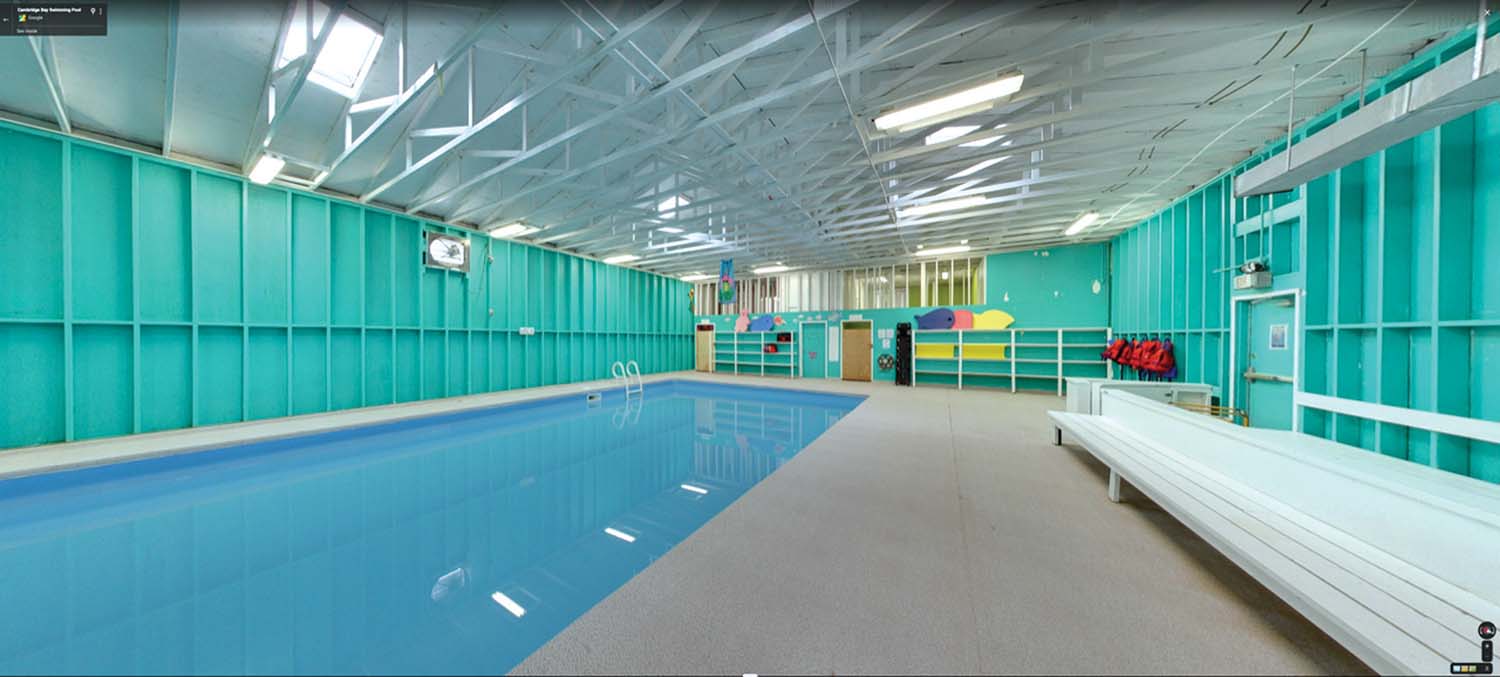Warm Waters

TEXT Alexandra Pereira-Edwards, Misca Birklein-Lagassé and Zaven Titizian
When a Google Street View team was invited to Nunavut, Canada, in 2012, their first stop was Iqaluktuuttiaq (ᐃᖃᓗᒃᑑᑦᑎᐊᖅ, Cambridge Bay). While those visiting the remote hamlet surveyed it using a Google Trike, members of the community were trained to use Google’s camera equipment and learned how to add roads to the online map. Capturing these images was an opportunity for Nunavummiut to present their community to the rest of the world.
One of the indoor spaces that got a 360-degree treatment was the Cambridge Bay pool, with its brightly painted plywood walls and laminated signage describing rules for pool use, admissions requirements, and notes on ice safety—reminders aimed at lowering the high drowning rates in the Territory.
While the pool remains virtually open for view, its recreational function in the community halted in July of 2019 when the hamlet closed the facility early in its already short season. The 30-year-old building was deemed structurally unsafe as a result of thawing permafrost, a reminder of the amplified effects of global warming in the community. Its deck was slumping, its metal was corroding, and the supports under its liner were weakening, threatening to suck swimmers under the building should the liner burst. The pool’s closure meant that the largely youthful users who would typically spend days playing and learning how to swim in the shallow, warm indoor waters no longer had the space to do so. And while the option to swim in Nunavut’s frigid natural waters does exist, many communities do not have designated spaces for submersion.
Similar structural problems expose a material fragility that impacts Nunavut’s built environment, leaving in their wake social and financial burdens for Northern communities. But the pools in Nunuvut also point to a deeper line of inquiry, one that questions Southern ideals of leisure and recreation enabled by these facilities. What biases are ascribed when Arctic water safety is taught within the confines of a pool? And where does Inuit knowledge locate itself inside aquatic facilities when it has been consistently resisted by a standardized swimming education? Cambridge Bay’s defunct pool, and others like it, serve as potent if contentious spaces to discuss layered histories, including ongoing settler colonial practices that continue to shape the Canadian Arctic.
By looking below the surface of the pool as a typology, discussions come into focus that unsettle the deep-rooted complicity of built form within Canada’s settler colonial narrative—and ultimately ask for retrospection and revision in how architectural research, scholarship, and practices are pursued.
Alexandra Pereira-Edwards, Misca Birklein-Lagassé, and Zaven Titizian were part of the 2020 Master’s Students Program at the Canadian Centre for Architecture (CCA), the first in a three-year thematic series entitled “In the Postcolony.” The research was guided by Rafico Ruiz, Associate Director of Research at the CCA, and in virtual conversation with Indigenous and non-Indigenous experts and guests. Their research developed into an open-access syllabus that questions settler colonial perspectives and research practices across design disciplines. The syllabus will be launched on the CCA’s website on November 23.
The research was pursued under the guidance of Rafico Ruiz, Associate Director of Research at the CCA, and in virtual conversation with invited guests. The authors would like to extend their thanks to Nicole Luke, Lola Sheppard, Mason White, Darin Barney, Audrey Giles, Ana María León, Paul Renzoni, Lisa Landrum, Geronimo Inutiq, Jocelyn Piirainen, Taqralik Partridge, and the CCA staff.
